Vertical gardening transforms limited spaces into lush, productive growing areas. Whether you have a tiny balcony, a small yard, or just a blank wall, growing upward lets you harvest fresh vegetables, herbs, and flowers in even the most space-challenged environments. This comprehensive guide will walk you through everything you need to know to create your first vertical garden, from planning and setup to maintenance and troubleshooting.
What Is Vertical Gardening?
Vertical gardening means growing plants upward instead of allowing them to spread across the ground. This gardening approach uses vertical space by training plants to grow up supports or by stacking growing containers. The concept is simple: when you can’t expand outward, expand upward!
At its core, vertical gardening involves any method that elevates plants off the ground. This could be as straightforward as growing climbing beans up a trellis or as elaborate as creating a living wall of herbs and flowers. The beauty of vertical gardening lies in its versatility and adaptability to almost any space.
Types of Vertical Gardens
There are several approaches to vertical gardening, each with its own advantages:
- Climbing gardens: Using trellises, arches, or stakes to support naturally climbing plants
- Container walls: Stacking or hanging containers on walls or fences
- Pocket gardens: Fabric pouches or specialized planters attached to vertical surfaces
- Tower gardens: Vertical structures with multiple planting spots around the sides
- Living walls: Dense plantings that create a wall-like appearance
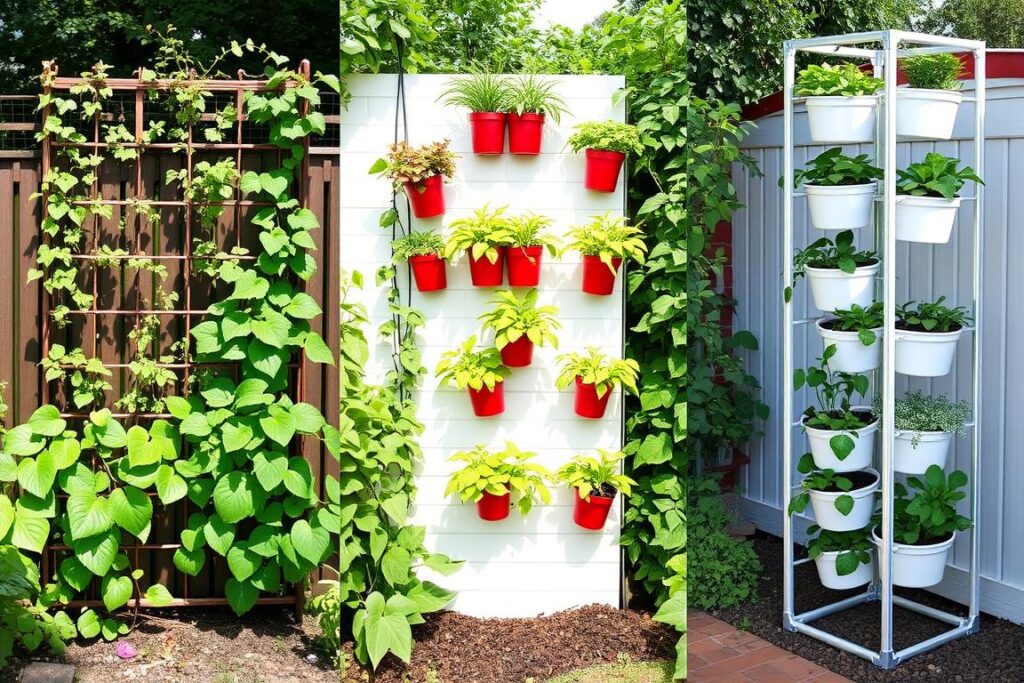
Benefits of Vertical Gardening
Growing vertically offers numerous advantages that make it perfect for beginners and experienced gardeners alike. Understanding these benefits will help you appreciate why vertical gardening has become so popular, especially in urban environments.
Maximizes Space
The most obvious benefit is space efficiency. A vining plant like squash can take up 20 square feet when grown on the ground, but only a few square feet when trained upward. This space-saving approach allows you to grow more in less area, making gardening possible even in the smallest spaces.
Improves Plant Health
Plants grown vertically enjoy better air circulation, which reduces moisture on leaves and prevents many fungal diseases. Keeping fruits and vegetables off the ground also protects them from soil-borne diseases, pests, and rot from ground contact. The result? Healthier plants with fewer problems.
Easier Harvesting
No more kneeling or bending to find hidden vegetables! Vertical gardening brings your harvest up to eye level, making it easier to spot ripe produce and harvest without straining your back. This accessibility makes gardening more enjoyable and less physically demanding.
Water Efficiency
Vertical systems can be designed to allow water to trickle down from top plants to lower ones, making efficient use of this precious resource. This cascading irrigation means less water waste and fewer trips with the watering can.
Enhanced Aesthetics
Vertical gardens add visual interest and can transform bland walls or fences into living works of art. The vertical dimension adds structure and beauty to your outdoor space while serving a practical purpose.
Pest Management
Elevating plants makes them less accessible to many ground-dwelling pests like slugs and snails. This natural pest barrier can reduce the need for pesticides and result in cleaner harvests.
Ready to grow more in less space?
Sign up for our newsletter and get our free “Vertical Gardening Quick-Start Guide” with printable planning templates!
Planning Your Vertical Garden
Successful vertical gardening starts with thoughtful planning. Taking time to assess your space, understand your growing conditions, and select the right system will set you up for success.
Assess Your Space
Before purchasing supplies or plants, evaluate your growing area:
- Sunlight: Track how many hours of direct sunlight your space receives. Most vegetables need 6-8 hours of sun daily.
- Wall/Surface Material: Different surfaces (wood, concrete, vinyl siding) require different mounting methods.
- Weight Capacity: Ensure your structure can support the weight of plants, soil, and water.
- Water Access: Consider proximity to water sources for easier maintenance.
- Climate Factors: Note exposure to wind, rain, or extreme temperatures.
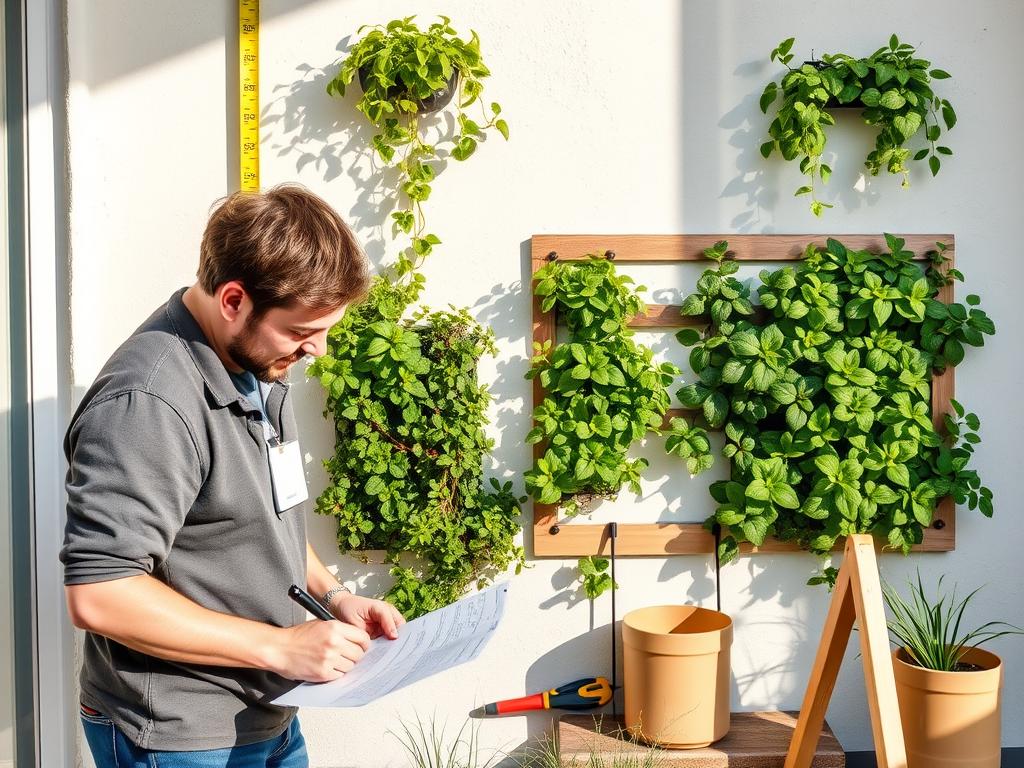
Choose Your Vertical Gardening System
Select a system that matches your space, budget, and gardening goals. Here are the most popular options for beginners:
| System Type | Best For | Cost Range | Difficulty Level | Ideal Plants |
| Trellis/Arch | Climbing vegetables | $15-$50 | Easy | Beans, peas, cucumbers, small melons |
| Pocket Planters | Herbs, small vegetables | $20-$100 | Easy | Herbs, lettuce, strawberries |
| Pallet Garden | Herbs, flowers | $0-$30 | Medium | Herbs, flowers, lettuce |
| Tower Garden | Mixed plantings | $30-$200 | Medium | Herbs, greens, strawberries |
| Living Wall | Decorative display | $100-$500+ | Advanced | Succulents, ferns, small flowers |
Budget-Friendly Options
Vertical gardening doesn’t have to be expensive. Here are some affordable alternatives to commercial systems:
- Welded Wire Fencing: About $35 for a 3′ x 50′ roll, which can be cut and shaped into multiple trellises.
- T-posts: Approximately $4 each, perfect for supporting wire fencing or netting.
- Cattle Panels: Around $20-30 each, can be bent into arches or used flat against walls.
- Recycled Materials: Old ladders, bed frames, or fencing can be repurposed at no cost.
- Clothesline: Simple strings run between posts work well for lightweight climbers like peas.
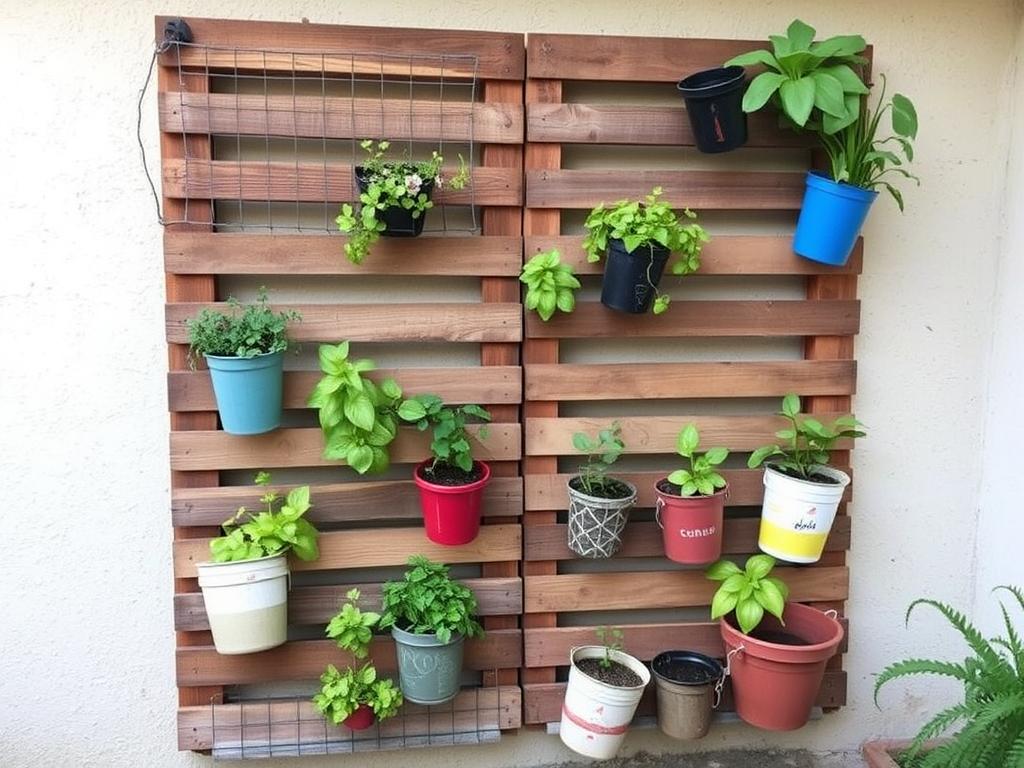
Best Plants for Vertical Gardening
Choosing the right plants is crucial for vertical gardening success. While many plants can grow vertically with proper support, some are naturally better suited to upward growth.
Vegetables That Thrive Vertically
Climbing Vegetables

- Pole Beans: ‘Romano Italian’, ‘Meraviglia Venezia’
- Peas: ‘Sugar Snap’, ‘Super Sugar Snap’
- Cucumbers: ‘Burpee Hybrid II’, ‘County Fair 83’
Vining Tomatoes

- Cherry Types: ‘Sungold’, ‘Black Cherry’
- Indeterminate: ‘Brandywine’, ‘Better Boy’
- Heirloom: ‘Cherokee Purple’, ‘Mortgage Lifter’
Trailing Squash

- Summer: Zucchini, Yellow Squash
- Winter: Acorn, Delicata, Butternut
- Melons: Small varieties like ‘Minnesota Midget’
Herbs and Flowers for Vertical Gardens
Herbs and flowers not only add beauty to vertical gardens but also attract beneficial insects and can repel certain pests.
Herbs
- Trailing Herbs: Thyme, oregano, mint
- Upright Herbs: Basil, parsley, cilantro
- Perennial Herbs: Rosemary, sage, lavender
Flowers
- Trailing Flowers: Nasturtium, sweet alyssum, lobelia
- Climbers: Morning glory, sweet peas, black-eyed Susan vine
- Compact Varieties: Marigolds, pansies, petunias
Pro Tip: When growing heavy fruits like melons or winter squash vertically, create slings from old t-shirts, pantyhose, or mesh bags to support the fruit as it develops. This prevents the weight from pulling the plant off its support.
Setting Up Your Vertical Garden: Step-by-Step
Now that you’ve planned your garden and selected your plants, it’s time to bring your vertical garden to life. Follow these steps for a successful setup.
Materials You’ll Need
- Your chosen vertical structure (trellis, cattle panel, etc.)
- Containers (if not planting in the ground)
- Quality potting soil or garden soil amended with compost
- Seeds or seedlings of your chosen plants
- Fasteners (zip ties, garden twine, hooks, etc.)
- Tools (drill, hammer, scissors, garden trowel)
- Watering equipment (watering can, hose, or drip irrigation)
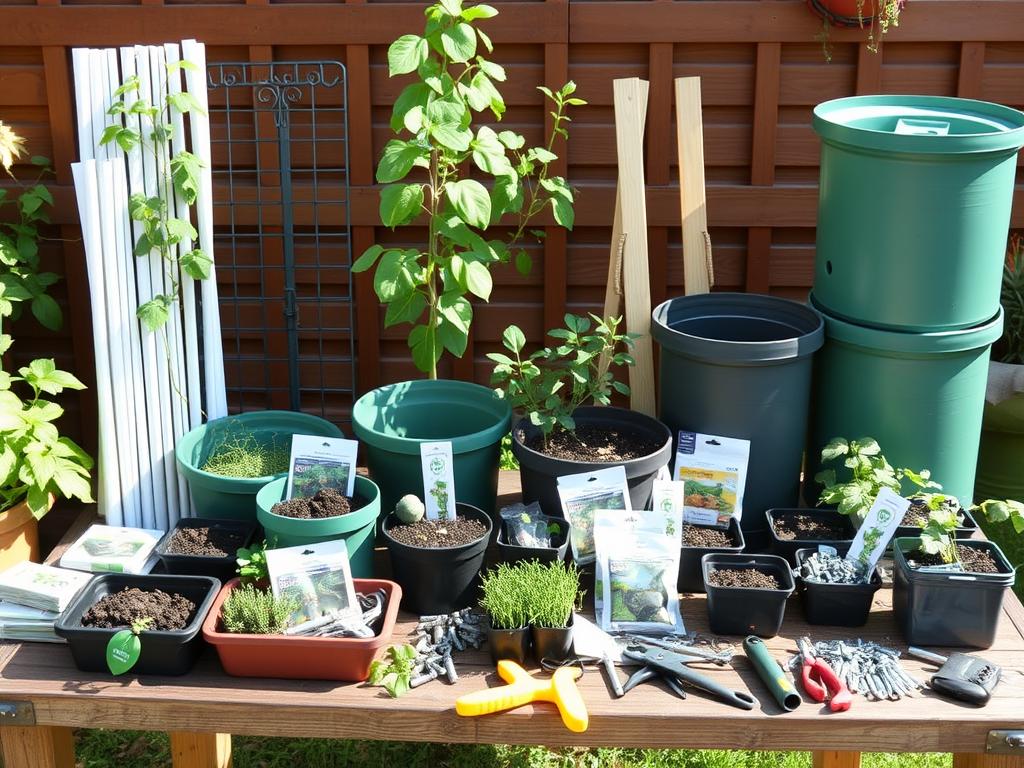
Three Easy Vertical Growing Methods
Here are three beginner-friendly methods to create your vertical garden:
1. Trellising Method
- Choose a location that receives adequate sunlight for your plants.
- Install sturdy vertical supports (t-posts, wooden posts) 4-6 feet apart.
- Attach horizontal supports at the top and bottom.
- Secure your trellis material (netting, wire, lattice) to the frame using zip ties or garden twine.
- Prepare the soil at the base of the trellis, adding compost for nutrients.
- Plant your climbing vegetables at the recommended spacing.
- As plants grow, gently guide them onto the trellis.
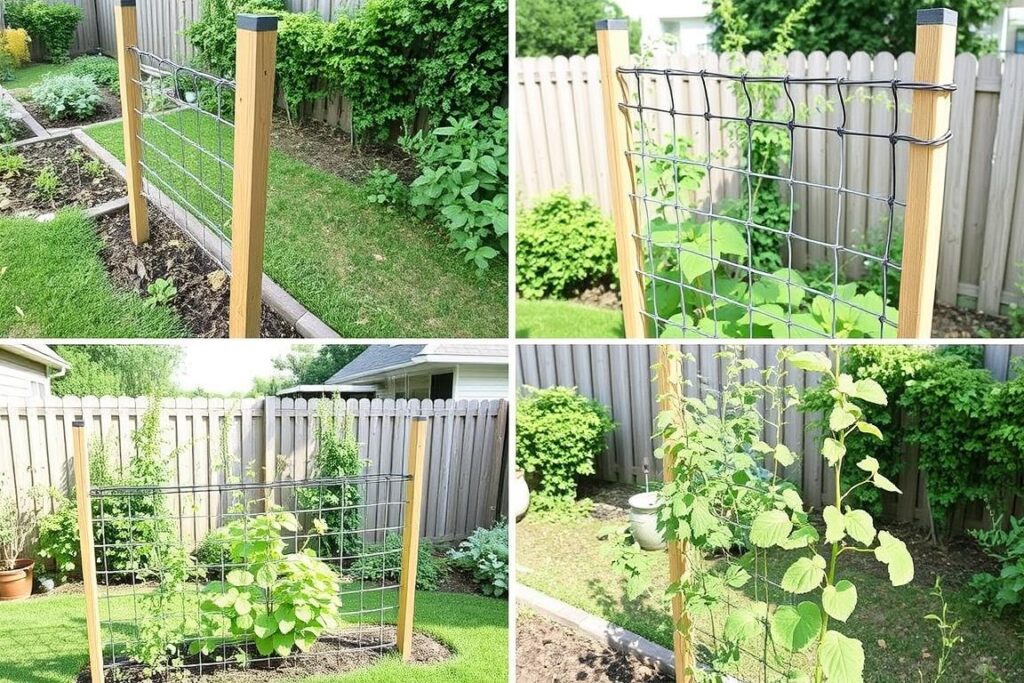
2. Staking Method
- For individual plants like tomatoes, insert a stake (wooden, bamboo, or metal) near the plant.
- As the plant grows, loosely tie it to the stake using soft garden twine or plant ties.
- For rows of plants, install stakes between every other plant.
- When plants reach 12 inches tall, weave garden twine between the stakes at 10-inch intervals.
- Add additional lines of twine as plants grow taller.
3. DIY Pallet Garden
- Find a pallet that’s marked HT (heat-treated) for safety.
- Sand rough edges to prevent splinters.
- Attach landscape fabric to the back and bottom using a staple gun.
- Lay the pallet flat and fill spaces with potting soil.
- Plant herbs, flowers, or small vegetables in the spaces.
- Water thoroughly and allow plants to establish for 1-2 weeks while keeping the pallet horizontal.
- Once plants are established, carefully tilt the pallet upright against a wall or fence.
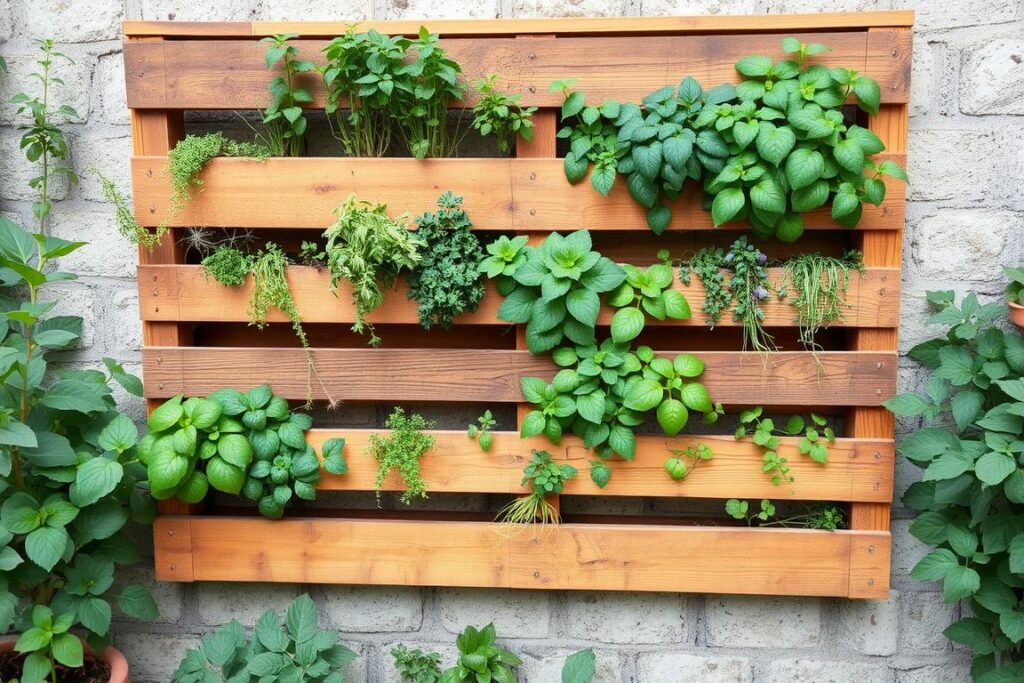
Need help planning your vertical garden?
Download our free vertical garden planning worksheet with space assessment tools, plant selection guides, and maintenance schedules!
Maintaining Your Vertical Garden
Proper maintenance ensures your vertical garden remains productive and healthy throughout the growing season. Here’s what you need to know about caring for your upward-growing plants.
Watering Techniques
Vertical gardens often need more frequent watering than ground-level gardens because:
- Containers dry out faster than in-ground plantings
- Plants may be exposed to more wind and sun
- Gravity pulls water downward, potentially leaving top plants dry
For efficient watering:
- Water in the morning to reduce evaporation
- Consider drip irrigation for consistent moisture
- Check soil moisture regularly by inserting your finger 1-2 inches into the soil
- Use self-watering containers or water-retaining soil amendments for container gardens
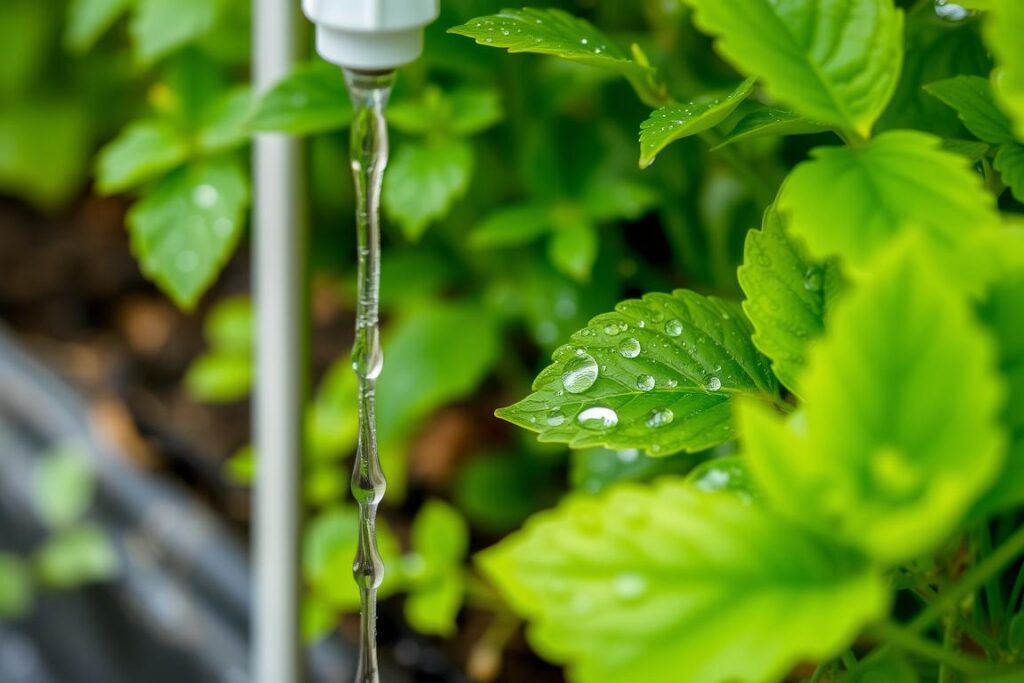
Training and Pruning
Regular attention to plant growth ensures your vertical garden remains manageable:
- Training: Gently guide young plants onto supports using soft ties or clips
- Pruning: Remove excessive side shoots on tomatoes and cucumbers to focus growth upward
- Thinning: Remove some fruits on heavy-bearing plants to prevent structure collapse
- Harvesting: Pick regularly to encourage continued production
Common Problems and Solutions
| Problem | Cause | Solution |
| Plants won’t climb | Insufficient support or wrong plant variety | Ensure you’re using climbing varieties; gently train plants onto supports |
| Structure leaning/collapsing | Too much weight or inadequate anchoring | Reinforce structure; use fruit slings; prune excess growth |
| Uneven watering | Gravity pulling water downward | Install drip irrigation; water top plants more frequently |
| Leaf yellowing | Nutrient deficiency in containers | Apply balanced liquid fertilizer every 2-3 weeks |
| Powdery mildew | Poor air circulation | Prune for better airflow; avoid overhead watering |
“The best fertilizer is the gardener’s shadow.” This old saying reminds us that regular attention is key to garden success. Check your vertical garden daily for watering needs and to catch problems early.
Seasonal Care for Vertical Gardens
Your vertical garden’s needs will change with the seasons. Here’s how to adapt your care routine throughout the year.
Spring

- Inspect and repair structures
- Refresh soil in containers
- Start seeds indoors for early planting
- Install irrigation systems
- Plant cool-season crops like peas
Summer

- Monitor water needs closely
- Provide shade during extreme heat
- Harvest regularly
- Check ties and supports
- Watch for pest issues
Fall/Winter

- Plant cool-season crops
- Harvest remaining summer crops
- Clean and store supports
- Add protection for winter-hardy plants
- Plan next year’s garden
Frequently Asked Questions
Can I grow root vegetables in a vertical garden?
Yes, but with adaptations. Shallow-rooted varieties of radishes, baby carrots, and small turnips can grow in deep pocket planters or tower gardens. Standard root vegetables generally need more soil depth than most vertical systems provide.
How much weight can a vertical garden support?
This depends entirely on your structure and mounting surface. Wall-mounted systems should be anchored into studs or masonry, not just drywall. Free-standing structures should have a wide, stable base. For heavy-fruiting plants like melons, use additional support slings for the fruit.
How much does it cost to start a vertical garden?
A basic DIY vertical garden can cost as little as -50 for materials like soil, seeds, and simple supports. Pre-made systems range from 0-500 depending on size and complexity. You can reduce costs by repurposing materials and starting small.
Can vertical gardens work indoors?
Absolutely! Indoor vertical gardens work well for herbs and some leafy greens. The key requirements are adequate light (natural or grow lights), proper drainage to protect floors and walls, and plants suited to indoor conditions. Herbs like basil, mint, and chives are excellent choices for indoor vertical gardens.
How do I prevent my vertical garden from damaging my wall?
Use a moisture barrier between the garden and the wall, ensure proper drainage, leave air space for circulation, and use appropriate anchoring methods for your wall type. Free-standing structures placed a few inches from the wall offer the best protection.
Start Your Vertical Garden Today
Vertical gardening opens up a world of possibilities for growing fresh food and beautiful plants in limited spaces. By starting small, choosing the right plants, and implementing the techniques we’ve covered, you can create a thriving vertical garden that maximizes your space and minimizes maintenance.
Remember that gardening is a journey of continuous learning. Don’t be discouraged by initial challenges—each season brings new knowledge and improved results. Your vertical garden will not only provide fresh harvests but also create a living, green space that enhances your environment.
Ready to transform your space with vertical gardening?
Join our community of vertical gardeners! Subscribe for seasonal tips, troubleshooting advice, and inspiration delivered straight to your inbox.

Will is a vertical gardening enthusiast and sustainable cultivation specialist with a passion for helping people grow fresh food in small spaces and dry climates. With years of hands-on experience testing smart irrigation systems, optimizing urban gardens, and exploring eco-friendly solutions, this author shares clear, practical tips to turn any corner into a productive garden. Whether on a sunny balcony or in a compact backyard, Will helps readers save water, maximize space, and enjoy healthy harvests year-round. When not tending to his plants, you’ll find him sipping herbal tea and sketching ideas for new sustainable projects.

